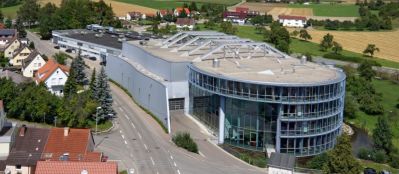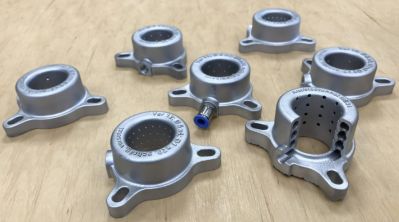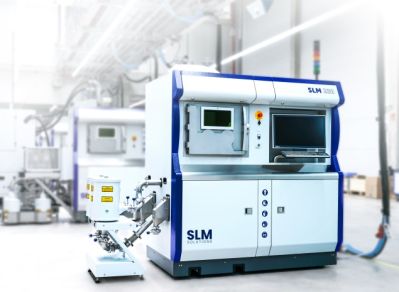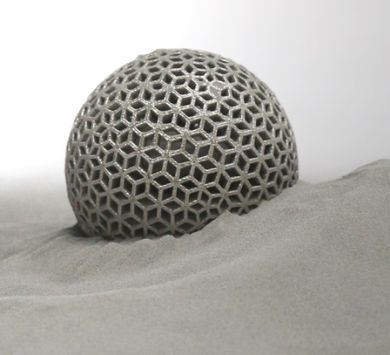Burgmaier Uses SLM's 3D Printing Process to Increase Machine Efficiency and Make Downtime a Thing of the Past
In the production of valve sleeves, many chips fly during machining. If these are not blown away properly, the machine stops and production stops. Why not use the potential of additive manufacturing (AM) and design a component that can handle the task better? What the engineers at Burgmaier have achieved is a real AM success story: With the new component, the machine has never stood still again.
Founded in 1931, Burgmaier is a German-based multi-national manufacturer of precision parts in large series. Around 350,000 parts leave the factory every day and statistically there are five Burgmaier parts in every European car.

Burgmaier Technologies in Allmendingen, Germany. The manufacturer employs around 700 in the overall operation.
Also headquartered in Germany, SLM Solutions is an integrated solutions provider and metal additive manufacturing partner. The company's Selective Laser Melting machines optimize fast, reliable and cost-efficient part production.
Burgmaier has recently combined its expertise in subtractive manufacturing with the unique advantages of SLM® additive manufacturing technology. By utilizing this pairing, filigree and bionic geometries are created in the shortest possible time. Lightweight structures, close to contour channels and the integration of new functions enable real added value for the products.
With the unique combination of milling and turning and the SLM® technology, the company also opens up new business models in the tooling industry. Application examples include an additively manufactured blow-out tunnel.

The costs for the development and 3D printing of the blow-off tunnel paid for themselves within days.
The additively manufactured blow-out tunnel is used to clean components in an automated production process.
After machining, chips and oil must be removed from the component before a measuring process is carried out in the next step. In the conventional design, chips on the component repeatedly lead to machine downtimes during measuring processes. Conventional air outlets cannot ensure cleanliness. On average, five machine downtimes per shift are the result. Manual intervention is necessary and overall costs increase. A total of five percent of the production volume per shift is affected.
To improve quality and the entire manufacturing process, it is necessary to revise the component design so that the compressed air reaches the component from all sides.

The SLM®280 2.0 is ideal for medium to high volume metal additive manufacturing part production and prototypes.
Burgmaier takes advantage of the SLM® AM technology and first integrates round air ducts, different duct cross sections and different outlet angles of the ducts. Burgmaier's team directly produced six different variants in one build job using the SLM®280 from SLM Solutions.
The new component performs the task much better than the previous solution, creates added value and reduces production costs.
After the evaluation, it was possible to switch to additive series production of the blow out tunnel in lightweight construction made of AlSi10Mg and in 30 µm layer thickness. With the help of SLM® technology, Burgmaier not only redesigned the component -- after installation, machine downtimes due to chips were reduced to zero, while at the same time the degree of utilization increased by seven percent.
Another positive aspect is that the noise level of the blow-out device is significantly lower than before. In addition, not only chips but also oil is removed. All in all, Burgmaier thus saves a high five-figure sum per year.
Additive manufacturing encompasses a variety of processes to build, however, they are all based on the same principle of adding material to create opposed to traditional methods that subtract material.

High-quality part production is directly correlated to the quality of metal powder.
Specifically, in selective laser melting a layer of metal powder is spread onto a substrate plate. Then lasers selectively melt powder to create the first layer of the build. A fresh layer of metal powder is evenly distributed over the build surface and the lasers melt each successive layer to the layers underneath until the desired component is produced.
Unlike laser sintering, selective laser melting completely melts each layer into the previous for completely dense metal parts. Compared to traditional manufacturing methods, additive manufacturing enables parts with complex geometric shapes and hollow structures to be produced.
With the help of this type of 3D printing, Burgmaier will continue to play a key role as a manufacturer of high-precision parts in the future automotive and networked world.
Want more information? Click below.
Rate this article
View our terms of use and privacy policy ::m::